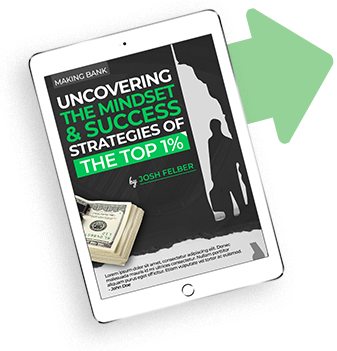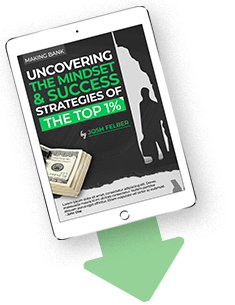The Formula of a Profitable Marketing Funnel
with Todd Brown
Video:
Audio:
with guest Todd Brown #MakingBank S4E8

The internet has changed the way people react to general information. Nowadays, people only need to search the internet to load hundreds of products to buy. So the challenge now is how do you convince people to prefer your product over your competitors?
In this article, you will learn the vital steps in creating a marketing funnel that generates sales. A marketing funnel breaks down the customer’s journey all the way from the awareness stage to purchase. However, the following steps are necessary in order to make it profitable.
- Create Awareness for Your Product or Services
The top of the funnel is the point where you inform your customers of your existence. Now, your customers may totally unaware of your business. Or they may know you but can’t find a reason why they should buy your product.
Consequently, the goal is to attract customers. There are many ways to raise awareness about your product such as online ads, direct email, social media promotions, and e-Books. The key is to expose, influence, and engage people about your product.
Other proven strategies include getting influencers to display your product, using branded packaging, inviting people to test your product, or setting up an online preview. Also think about how powerful SEO is. You can leverage SEO in all your product ads make it searchable on Google.
2. Spark Interest in What You Have To Offer
Valuable offer attracts more traffic than general ones. Despite having attractive ads the number of people that goes to your site will remain low if there’s no value in your offer. You can decide on the strategy to capture your audience. But to put more value to it, do not just sell information. People need specific frameworks and methodologies.
Say you’re selling an app that helps automate podcasts. Don’t just say these are the “Five Tips for This…” or “Seven Ways to Do that…” They can find similar information in other websites. Instead go directly to the point. You can say this app helps you automate podcasts and “reduce them down from 7 to 3 hours.” The idea is to offer what people want to know. It must be unique, straightforward, and valuable.
3. Nurture Desire to Buy Through Education
When leads get to the middle of the funnel, educating them becomes necessary. It helps cultivate interest with your existing leads and a build healthy relationship with prospects over time.
When it comes to marketing, education means more than just telling prospects what you’re putting in your product. Say you’re selling a natural supplement. Tell your prospects the unique formulation of your product and inform them why they don’t need to look further.
You can say that your supplement has a combination of all the necessary vitamins and minerals, and it is the cheapest in the market so far. Then you can start discussing about the specific benefits of each vitamin and mineral. For example, if your product contains calcium, magnesium, iron, and zinc in one formulation. Your goal is to educate them about the benefits of combing these minerals. Tell them these are supposed to be expensive but you’re selling them at a lower price “because of this and that.”
Tell them how your products work and show proof of results either through experiments, tests, or testimonials. When your information is complete and marketable, customers will no longer look into other products.

4. Help Your Leads Perform a Desirable Action
Now, your prospects are developing interest in your product. The next thing to do is to encourage them to do something through a CTA. CTA means “Call to Action” which can be part of your story, webpage, advertisement, or content. It helps convert readers into leads for your sales team. It can either be a copy or a graphic you can use to persuade prospects to take action. Remember that a creative call to action can dramatically drive attention and increase the conversion rate.
You can call your audience to sign up, subscribe for a free trial, get started, learn more or join your community. Giving them a few actions to carry out move your prospects and make them actualize an instant response.
To make your call to action work, make it as specific as possible. Tell the user exactly what you want them to do and place some urgency. For example, you can say “Click Now” or “Try Our Software Today.”
5. Move Leads to the End of the Funnel to Make Purchases
Your goal at the bottom of the funnel is to convert leads into customers who buy your products. The purchase decision is the conclusion of all your efforts throughout the marketing funnel.
This is when your prospects have determined that your offer is great, found value in your products, and decided what’s best for them. And now they are ready to pull out their wallets and purchase your product.
The bottom of the marketing funnel is the most important part of the pyramid because this is where you make it or break it. At this stage, content can help your prospects feel confident in their decision to purchase your product.
Content does not only educate but also engages your prospects. Some examples of good content are case studies, blogs, customer testimonials, and product reviews. The focus of your content also depends on the type your market. Say if you’re selling science-based products, then case studies would be ideal. But if you’re selling IT based solutions then “how to” blogs will be more effective than the former.
Building a profitable marketing funnel takes a lot of effort. But if you take the time to do it, you will earn a nice bump in your profit.
The key to a profitable marketing funnel is starting at the top and gradually working your way at the bottom. Every marketing funnel is customizable according to your need. Another key is to be creative.
Focus on making the correct offer and nurturing your prospects. Showcase success of previous customers and then capitalize on positive feedback.
Topics
- Accelerated Learning
- Artificial Intelligence
- Become Present
- Blockchain
- Branding
- Business
- Education
- Entrepreneurship
- Family
- Finance
- Health
- Health & Wellness
- Internet Marketing
- Investing
- Leadership
- Lifecoach
- Marketing
- Negotiation
- Performance
- Productivity
- Publicity
- Real Estate
- Sales
- Sales Success Habits
- Video Marketing
- Writing















